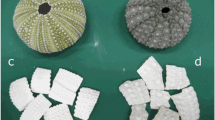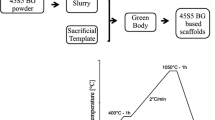Abstract
Evidence that otoliths, mineral-rich limestone concrescences present in the inner ear of bone fishes, can accelerate bone formation in vivo has been previously reported. The goal of this work was the development, characterization, and evaluation of the cytocompatibility of otoliths-incorporated sodium alginate and gelatin scaffolds. Cynoscion acoupa–derived otoliths were characterized by X-ray fluorescence spectrometry (FRX), particle size, free lime, and weight loss by calcination. Furthermore, otoliths were incorporated into sodium alginate (ALG/OTL-s) or gelatin (GEL/OTL-s) scaffolds, previously developed by freeze-drying. Then, the scaffolds were characterized by thermogravimetric analysis (TGA/DTG), differential scanning calorimetry (DSC), infrared spectroscopy with Fourier transform (FTIR), swelling tests, and scanning electron microscopy (SEM). Cytotoxicity assays were run against J774.G8 macrophages and MC3T3-E1 osteoblasts. Data obtained from TGA/DTG, DSC, and FTIR analyses confirmed the interaction between otoliths and the polymeric scaffolds. SEM showed the homogeneous porous 3D structure rich in otolith micro-fragments in both scaffolds. Swelling of the GEL/OTL-s (63.54 ± 3.0%) was greater than of ALG/OTL-s (13.36 ± 9.9%) (p < 0.001). The viability of J774.G8 macrophages treated with both scaffolds was statistically similar to the group treated with DMEM only (p > 0.05) and significantly higher than that treated with Triton-X (p < 0.01) at 72 h. Both scaffolds showed approximately 100% growth of MC3T3-E1 osteoblasts by 24 h, similarly to control (p > 0.05). However, by 48 h, only ALG/OTL-s showed growth similar to control (p > 0.05), whereas GEL/OTL showed a significantly lower growth index (p < 0.05). In conclusion, the physicochemical profiles suggest proper interaction between the otoliths and the two developed polymeric 3D scaffolds. Moreover, both materials showed cytocompatibility with J774.G8 macrophages but the growth of MC3T3-E1 osteoblasts was higher when exposed to ALG/OTL-s. These data suggest that sodium alginate/otoliths scaffolds are potential biomaterials to be used in bone regeneration applications.

Graphical abstract








Similar content being viewed by others
References
Ghassemi T, Shahroodi A, Ebrahimzadeh MH, Mousavian A, Movaffagh J, Moradi A. Current concepts in scaffolding for bone tissue engineering. Arch Bone Jt Surg. 2018;6(2):90–9.
Orshesh Z, Borhan S, Kafashan H. Physical, mechanical and in vitro biological evaluation of synthesized biosurfactant-modified silanated-gelatin/sodium alginate/45S5 bioglass bone tissue engineering scaffolds. J Biomater Sci Polym Ed. 2020;31(1):93–109. https://doi.org/10.1080/09205063.2019.1675226.
Kolbuk D, Heljak M, Choinska E, Urbanek O. Novel 3D hybrid nanofiber scaffolds for bone regeneration. Polymers (Basel). 2020;12(3). https://doi.org/10.3390/polym12030544.
Lv J, Liu W, Shi G, Zhu F, He X, Zhu Z, et al. Human cardiac extracellular matrix-chitosan-gelatin composite scaffold and its endothelialization. Exp Ther Med. 2020;19(2):1225–34. https://doi.org/10.3892/etm.2019.8349.
Cheng CH, Lai YH, Chen YW, Yao CH, Chen KY. Immobilization of bone morphogenetic protein-2 to gelatin/avidin-modified hydroxyapatite composite scaffolds for bone regeneration. J Biomater Appl. 2019;33(9):1147–56. https://doi.org/10.1177/0885328218820636.
Narayanaswamy R, Torchilin VP. Hydrogels and their applications in targeted drug delivery. Molecules. 2019;24(3):603. https://doi.org/10.3390/molecules24030603.
Izzo C, Doubleday ZA, Gillanders BM. Where do elements bind within the otoliths of fish? %J. Mar Freshw Res. 2016;67(7):1072–6. https://doi.org/10.1071/MF15064.
Weigele J, Franz-Odendaal TA, Hilbig R. Spatial expression of otolith matrix protein-1 and otolin-1 in normally and kinetotically swimming fish. Anat Rec. 2015;298(10):1765–73. https://doi.org/10.1002/ar.23184.
Murayama E, Takagi Y, Ohira T, Davis JG, Greene MI, Nagasawa H. Fish otolith contains a unique structural protein, otolin-1. Eur J Biochem. 2002;269(2):688–96. https://doi.org/10.1046/j.0014-2956.2001.02701.x.
Murayama E, Takagi Y, Nagasawa H. Immunohistochemical localization of two otolith matrix proteins in the otolith and inner ear of the rainbow trout, Oncorhynchus mykiss: comparative aspects between the adult inner ear and embryonic otocysts. Histochem Cell Biol. 2004;121(2):155–66. https://doi.org/10.1007/s00418-003-0605-5.
De Olyveira GM, Valido DP, Costa LMM, Gois PBP, Xavier-Filho L, Basmaji P. Otoliths/collagen/bacterial cellulose nanocomposites as a potential scaffold for bone tissue regeneration. J Biomater Nanobiotechnol. 2011;2:239–43. https://doi.org/10.4236/jbnb.2011.23030.
Orimo H. The mechanism of mineralization and the role of alkaline phosphatase in health and disease. J Nippon Med Sch. 2010;77(1):4–12. https://doi.org/10.1272/jnms.77.4.
Galow A-M, Rebl A, Koczan D, Bonk SM, Baumann W, Gimsa J. Increased osteoblast viability at alkaline pH in vitro provides a new perspective on bone regeneration. Biochem Biophys Rep. 2017;10:17–25. https://doi.org/10.1016/j.bbrep.2017.02.001.
Dawson ER, Suzuki RK, Samano MA, Murphy MB. Increased internal porosity and surface area of hydroxyapatite accelerates healing and compensates for low bone marrow mesenchymal stem cell concentrations in critically-sized bone defects. Applied Sci 2018;8(8):1366.
Lebre F, Sridharan R, Sawkins MJ, Kelly DJ, O’Brien FJ, Lavelle EC. The shape and size of hydroxyapatite particles dictate inflammatory responses following implantation. Sci Rep. 2017;7(1):2922. https://doi.org/10.1038/s41598-017-03086-0.
Cavalcante AM, Lima JCS, Santos LM, Oliveira PCC, Ribeiro Júnior KAL, Sant’ana AEG. Comparative evaluation of the pH of calcium hydroxide powder in contact with carbon dioxide (CO2). J Mater Res. 2010;13:1–4.
Zhang D, Wu X, Chen J, Lin K. The development of collagen based composite scaffolds for bone regeneration. Bioactive Mater. 2018;3(1):129–38. https://doi.org/10.1016/j.bioactmat.2017.08.004.
Yu W, Sun T-W, Qi C, Ding Z, Zhao H, Zhao S, et al. Evaluation of zinc-doped mesoporous hydroxyapatite microspheres for the construction of a novel biomimetic scaffold optimized for bone augmentation. Int J Nanomedicine. 2017;12:2293–306. https://doi.org/10.2147/IJN.S126505.
Dongni R, Yonghua G, Qingling F. Comparative study on nano-mechanics and thermodynamics of fish otoliths. Mater Sci Eng C Mater Biol Appl. 2013;33(1):9–14. https://doi.org/10.1016/j.msec.2012.07.023.
Kavoosi G, Derakhshan M, Salehi M, Rahmati L. Microencapsulation of zataria essential oil in agar, alginate and carrageenan. Innovative Food Sci Emerg Technol. 2018;45:418–25. https://doi.org/10.1016/j.ifset.2017.12.010.
Shehap AM, Mahmoud K, El-Kader MFA, El-Basheer TM. Preparation and thermal properties of gelatin/TGS composite films. Middle East J Appl Sci. 2015;5:157–70.
Dong Y, Dong W, Cao Y, Han Z, Ding Z. Preparation and catalytic activity of Fe alginate gel beads for oxidative degradation of azo dyes under visible light irradiation. Catal Today. 2011;175(1):346–55. https://doi.org/10.1016/j.cattod.2011.03.035.
Liu Y, Zhou Y, Jiang T, Liang YD, Zhang Z, Wang YN. Evaluation of the osseointegration of dental implants coated with calcium carbonate: an animal study. Int J Oral Sci. 2017;9(3):133–8. https://doi.org/10.1038/ijos.2017.13.
De Souza SPMC, de Morais FE, dos Santos EV, Martinez-Huitle CA, Fernandes NS. Determination of calcium content in tablets for treatment of osteoporosis using thermogravimetry (TG). J Therm Anal Calorim. 2011;111(3):1965–70. https://doi.org/10.1007/s10973-011-2119-z.
Montañez-Supelano ND, Estupiñan-Durán HA, García SJ, Peña-Ballesteros DY. Fabrication and characterization of novel biphasic calcium phosphate and nanosized hydroxyapatite derived from fish otoliths in different composition ratios. Chem Eng Trans. 2018;64:307–12. https://doi.org/10.3303/CET1864052.
Mirzaei B, Etemadian S, Goli HR, Bahonar S, Gholami SA, Karami P, et al. Construction and analysis of alginate-based honey hydrogel as an ointment to heal of rat burn wound related infections. Int J Burns Trauma. 2018;8(4):88–97.
Poddar S, Agarwal PS, Sahi AK, Vajanthri KY, Pallawi, Singh KN, et al. Fabrication and cytocompatibility evaluation of psyllium husk (Isabgol)/gelatin composite scaffolds. Appl Biochem Biotechnol. 2019;188(3):750–68. https://doi.org/10.1007/s12010-019-02958-7.
Nezhadi SH, Choong PF, Lotfipour F, Dass CR. Gelatin-based delivery systems for cancer gene therapy. J Drug Target. 2009;17(10):731–8. https://doi.org/10.3109/10611860903096540.
Verma V, Verma P, Kar S, Ray P, Ray AR. Fabrication of agar-gelatin hybrid scaffolds using a novel entrapment method for in vitro tissue engineering applications. Biotechnol Bioeng. 2007;96(2):392–400. https://doi.org/10.1002/bit.21111.
Pan T, Song W, Cao X, Wang Y. 3D bioplotting of gelatin/alginate scaffolds for tissue engineering: influence of crosslinking degree and pore architecture on physicochemical properties. J Mater Sci Technol. 2016;32(9):889–900. https://doi.org/10.1016/j.jmst.2016.01.007.
Yang H, Zhao X, Xu Y, Wang L, He Q, Lundberg YW. Matrix recruitment and calcium sequestration for spatial specific otoconia development. PLoS One. 2011;6(5):e20498. https://doi.org/10.1371/journal.pone.0020498.
Abdal-hay A, Khalil KA, Hamdy AS, Al-Jassir FF. Fabrication of highly porous biodegradable biomimetic nanocomposite as advanced bone tissue scaffold. Arab J Chem. 2017;10(2):240–52. https://doi.org/10.1016/j.arabjc.2016.09.021.
Gentile P, Nandagiri VK, Daly J, Chiono V, Mattu C, Tonda-Turo C, et al. Localised controlled release of simvastatin from porous chitosan-gelatin scaffolds engrafted with simvastatin loaded PLGA-microparticles for bone tissue engineering application. Mater Sci Eng C Mater Biol Appl. 2016;59:249–57. https://doi.org/10.1016/j.msec.2015.10.014.
Rezwan K, Chen QZ, Blaker JJ, Boccaccini AR. Biodegradable and bioactive porous polymer/inorganic composite scaffolds for bone tissue engineering. Biomaterials. 2006;27(18):3413–31. https://doi.org/10.1016/j.biomaterials.2006.01.039.
Dizaj SM, Barzegar-Jalali M, Zarrintan MH, Adibkia K, Lotfipour F. Calcium carbonate nanoparticles; potential in bone and tooth disorders. Pharm Sci. 2015;20(3):175–82.
Kamba AS, Ismail M, Ibrahim TA, Zakaria ZA. Biocompatibility of bio based calcium carbonate nanocrystals aragonite polymorph on NIH 3T3 fibroblast cell line. Afr JTradit Complement Altern Med. 2014;11(4):31–8. https://doi.org/10.4314/ajtcam.v11i4.5.
Author contribution statement
Conceptualization: Daisy Pereira Valido. Methodology: Wilson Déda Gonçalves Júnior, Maria Eliane de Andrade, Allan Andrade Rezende, Felipe Mendes de Andrade de Carvalho, Renata de Lima, Gabriela das Graças Gomes Trindade, Caio de Alcântara Campos, Ana Maria Santos Oliveira, Eloísa Portugal Barros Silva Soares de Souza, Luiza Abrahão Frank. Formal analysis and investigation: Silvia Stanisçuaski Guterres. Writing - original draft preparation: Eliana Midori Sussuchi, Charlene Regina Santos Matos, André Polloni, Adriano Antunes de Souza Araújo, Patrícia Severino. Writing - review and editing: Eliana Barbosa Souto. Funding acquisition: Francine Ferreira Padilha, Supervision: Ricardo Luiz Cavalcanti de Albuquerque Júnior.
Funding
We would like to thank the National Council for Scientific and Technological Development (CNPq) and the Foundation for Research and Technological Innovation Support of the State of Sergipe for the financial support in this study. EMBS acknowledges the sponsorship of the projects M-ERA-NET-0004/2015-PAIRED and UIDB/04469/2020 (strategic fund), received support from the Portuguese Science and Technology Foundation, Ministry of Science and Education (FCT/MEC) through national funds, and was co-financed by FEDER, under the Partnership Agreement PT2020.
Author information
Authors and Affiliations
Corresponding authors
Ethics declarations
Conflict of interest
The authors declare that they have no conflict of interest.
Additional information
Publisher’s note
Springer Nature remains neutral with regard to jurisdictional claims in published maps and institutional affiliations.
Rights and permissions
About this article
Cite this article
Valido, D.P., Júnior, W.D.G., de Andrade, M.E. et al. Otoliths-composed gelatin/sodium alginate scaffolds for bone regeneration. Drug Deliv. and Transl. Res. 10, 1716–1728 (2020). https://doi.org/10.1007/s13346-020-00845-x
Published:
Issue Date:
DOI: https://doi.org/10.1007/s13346-020-00845-x




